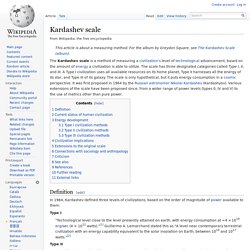

Paul Hughes: Exotic Civilizations: A Possible Answer To Fermi's Paradox. By Most science fiction and scientific speculation regarding our future advancement and that of advanced extraterrestrial civilizations, follows a path of increasingly visible expansion out into the galaxy. It starts first with colonization of the planets of their home star system, followed by interstellar travel, interstellar colonies, interstellar federations or empires, then out further to more and more of the galaxy, until you have a galactic wide civilization.
Since we haven’t seen any of evidence of these advanced civilizations, the argument goes that that such a strong lack of evidence can only mean one thing - there are no advanced extraterrestrial civilizations. As I will argue, this is an incredibly premature conclusion. A scheme for classifying such advanced technological civilizations was proposed by Nikolai Kardashev in 1964. . : Controls the energy of an entire planet. . : Controls the energy of an entire star. . : Controls the energy of an entire galaxy. {*style:<b> </i>*} Kardashev scale. The Kardashev scale is a method of measuring a civilization's level of technological advancement, based on the amount of energy a civilization is able to utilize.

The scale has three designated categories called Type I, II, and III. A Type I civilization uses all available resources on its home planet, Type II harnesses all the energy of its star, and Type III of its galaxy. The scale is only hypothetical, but it puts energy consumption in a cosmic perspective. It was first proposed in 1964 by the Russian astronomer Nikolai Kardashev (Kardashyov).
Various extensions of the scale have been proposed since, from a wider range of power levels (types 0, IV and V) to the use of metrics other than pure power. Definition[edit] Type I "Technological level close to the level presently attained on earth, with energy consumption at ≈4×1019 erg/sec (4 × 1012 watts) Type II Type III "A civilization in possession of energy on the scale of its own galaxy, with energy consumption at ≈4×1044 erg/sec.
Type III Civilizations. Type III Civilizations are civilizations that have control over at least an entire galaxy, and theoretically are able to harness all the power available in that galaxy.

Examples of Type III Civilizations Edit In these examples, the exact power consumption of their entire civilizations is often unknown. They are estimated to be type II based on the scope of their influence and technology. IE, civilizations with FTL drives and control over entire galaxies, or with abilities to affect the universe on the planetary scale. The following examples are a different type of civilization from the ones previously mentioned. Type II Civilizations. Type II Civilizations are civilizations that have control over more than one stellar system, and theoretically are able to harness all the power available in a single star.

So, a civilization that employs some form of faster-than-light travel is likely to be considered a Type II Civilization. Examples of Type II Civilizations Edit In these examples, the exact power consumption of their entire civilizations is often unknown. They are estimated to be type II based on the scope of their influence and technology. The following examples are a different type of civilization from the ones previously mentioned. The Morlocks from the novel, The Time Ships (But not the ones from The Time Machine): These Morlocks have built a form of Dyson Sphere around the sun, harnessing all of its energy output.
See Also. Type I Civilizations. Type 0 Civilizations. Dr. Michio Kaku about Future Civilizations.